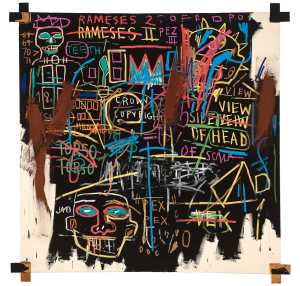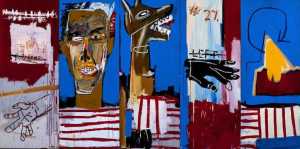The photograph ‘Midsummer Night’s Mare’ was made by Philippe Halsman in collaboration with the Surrealist Salvador Dalí. Halsman had just made his breakthrough as a portrait photographer when he met Dalí in 1941. Halsman photographed Dalí in dozens of fantasy decors, including as an embryo in an egg and alongside a skull made up of naked women. In ‘Midsummer Night’s Mare’, a pun on the title of Shakespeare’s famous romantic comedy ‘A Midsummer Night’s Dream’, a festive group is suspended in a woodland setting. In the foreground we see Dalí with a sheep. The artist is transported into a fairy tale via the medium of photography.

Specifications
| Title | Midsummer Night's Mare |
|---|---|
| Material and technique | Hand-coloured gelatin silver print on fibre-based paper |
| Object type |
Photograph
> Two-dimensional object
> Art object
|
| Location | This object is in storage |
| Dimensions |
Width 49,7 cm Height 38,7 cm |
|---|---|
| Artists |
Artist:
Salvador Dalí
Photographer: Philippe Halsman |
| Accession number | 3561 (MK) |
| Credits | Purchased 2005 |
| Department | Modern Art |
| Acquisition date | 2005 |
| Creation date | in circa 1944 |
| Entitled parties | © Salvador Dalí, Fundación Gala-Salvador Dalí, c/o Pictoright Amsterdam 2022 |
| Provenance | Artist’s family; Howard Greenberg Gallery, New York |
| Exhibitions | Rotterdam 2011; Rotterdam 2013-14a; Rotterdam 2017b |
| Internal exhibitions |
Surreëel: foto's uit de collectie van Museum Boijmans Van Beuningen (2011) Een paraplu, een naaimachine en een ontleedtafel. Surrealisme à la Dalí in Rotterdam. (2013) Collectie - surrealisme (2017) |
| External exhibitions |
Dal nulla al sogno (2018) |
| Research |
Show research A dream collection - Surrealism in Museum Boijmans Van Beuningen |
| Literature | Feldhaus 2015, pp. 52, 59; Rotterdam/Barcelona/Madrid 2005, p. 294 |
| Material | |
| Object | |
| Technique |
Gelatine silver print
> Bromide print
> Photographic printing technique
> Mechanical
> Planographic printing
> Printing technique
> Technique
> Material and technique
|
Do you have corrections or additional information about this work? Please, send us a message
Entry catalogue A dream collection - Surrealism in Museum Boijmans Van Beuningen
Author: Marijke Peyser
The title of the carefully staged photograph Midsummer Night’s Mare was derived from the comedy William Shakespeare wrote at the end of the sixteenth century. In his Midsummer Night’s Dream (1595), four young lovers spend a night in a forest near Athens: Hermia loves Lysander, Helena loves Demetrius. All kinds of circumstances contribute to the fact that the partners are swapped. In the end it all turns out well: the original pairs of lovers find each other again. The title of the photograph, Midsummer Night’s Mare, however, does not bode well.
Salvador Dalí and the photographer Philippe Halsman remained close to Shakespeare’s scene with four elegantly dressed young men and women in an illuminated woodland setting. But there are new, unexpected and threatening image elements. Dalí, prominently in the foreground, demands attention. He looks straight at the viewer while carefully grasping a lamb standing in front of him with both hands. A second lamb in the background, harnessed and suspended between two ropes, barely in balance, hangs above a laid table with a number of knives stuck in it. The man in the dinner jacket on the right who leaps into the scene behind Dalí calls to mind the famous photograph Dalí Atomicus (1948) that Halsman and Dalí made, which features three floating cats, a chair and a leaping Dalí. Halsman was known for getting his models to jump because they were concentrating so much on jumping that they dropped their mask.[1]
The terrified lamb may refer to Dalí’s personal fears and obsessions. When Dalí introduced his mistress Gala to his father Don Salvador Dalí Cusí in 1929, the latter strongly disapproved of their relationship. When he saw the provocative portrait Dalí made of his mother, Parfois je crache par plaisir sur le portrait de ma mère (Le sacré-coeur) (1929), he had had enough: Dalí was thrown out of the house. In his biography The Secret Life of Salvador Dalí (1942) the artist wrote: ‘As soon as we had got settled in Port Lligat I painted a portrait of Gala with a pair of raw lamb chops poised on her shoulder. The meaning of this, as I later learned, was that instead of eating her, I had decided to eat a pair of raw lamb chops instead. The chops were in effect the expiatory victims of abortive sacrifice – like Abraham’s ram, and William Tell’s apple. I drew it several times, with this thought in my head, my portrait as a child with a raw lamb chop on my head; I was trying symbolically to persuade my father to eat the lamb chop instead of his son.’[2]
Over the years Dalí and Halsman worked closely together on various projects. A photograph of Dalí naked in an egg illustrates the Spaniard’s claim that he had memories that went back to the time he had spent in the womb.[3] In 1951 Dalí and Halsman completed In Voluptas Mors, a sensational tableau vivant. The photograph is of seven nude women positioned in such a way that together they form a skull. Dalí stands beside them. In the publication Dalí’s Moustache (1954) the artist’s trademark takes centre stage. The often amusing photos in this publication were created thanks to the photographer’s technical skill and the duo’s innovative ideas.
All about the artist
Salvador Dalí
Figueras 1904 - Figueras 1989
Salvador Dali got to know the author André Breton - the founder of the surrealist movement - while he was studying in Madrid. In 1924, Breton wrote the first...
Bekijk het volledige profiel






















